Use a client-to-site VPN to let mobile workers connect securely to your CloudGen Firewall. Each client must have a valid client certificate as well as the username and password to authenticate. The client must use the Barracuda VPN Client or CudaLaunch on Android to connect to the firewall via the TINA VPN protocol. By default, each user can have only one concurrent client-to-site VPN connection. An Advanced Remote Access subscription is required to enable concurrent client-to-site VPN sessions by the same user. You can connect from any IPv4 or IPv6 address, as long as an external IPv4 and IPv6 address are configured as a service IP address for the VPN service. Traffic passing through the client-to-site VPN is limited to IPv4.

Supported VPN Clients
The following clients are supported for this client-to-site configuration:
- CudaLaunch for Android via VPN templates in SSL VPN. For more information, see How to Configure VPN Group Policies in the SSL VPN.
- VPN Client & Network Access Client
Before You Begin
- Set up the VPN certificates for External CA. For more information, see How to Set Up External CA VPN Certificates.
- Configure an external or local authentication service. For more information, see Authentication.
- Identify the subnet and gateway address to use for the VPN service in your network (e.g.,
192.168.6.0/24and192.168.6.254). - Identify the IPv4 and IPv6 addresses the VPN service is listening on. If you are using a dynamic WAN IP, see How to Configure VPN Access via a Dynamic WAN IP Address.
Step 1. Configure the VPN Service Listeners
Configure the IPv4 and IPv6 listener addresses for the VPN service.
- Go to CONFIGURATION > Configuration Tree > Box > Assigned Services > VPN-Service > Service Properties.
- Click Lock.
- From the Listening IP list, select the source for the IPv4 listeners for the VPN service.
When selecting Explicit, click + for each IP address and enter the IPv4 addresses in the Explicit Service IPs list.
- Click + to add an entry to the Explicit IPv6 IPs.
- Select an IPv6 listener from the list of configured explicit IPv6 service IP addresses.
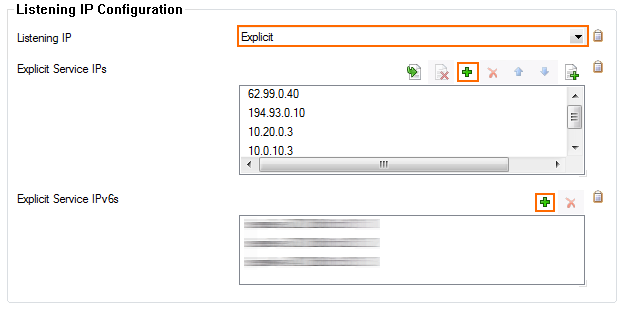
- Click Send Changes and Activate.
Step 2. Create the VPN Client Network
All VPN clients will receive an IP address from the VPN client network with a static gateway. You can choose the gateway IP address freely from the subnet.
- Go to CONFIGURATION > Configuration Tree > Box > Assigned Services > VPN-Service > VPN Settings.
- Click Lock.
- Verify that the Default Server Certificate and Private key are both valid (green). If the Default Server Certificate and Private key are not valid, see How to Set Up Barracuda VPN CA VPN Certificates.
- Configure the client network.
- In the left menu, select Client Networks.
- Right-click the table and select New Client Network. The Client Network window opens.
- In the Client Network window, configure the following settings either for IPv4 and/or IPv6. If IPv6 is globally disabled, the section for IPv6 is displayed in ghosted colors and cannot be enabled:
Name – Enter a descriptive name for the network.
- Type – Select routed (Static Route). VPN clients are assigned an address via DHCP (fixed or dynamic) in a separate network reserved for the VPN. A static route on the firewall leads to the local network.
Network Address – Enter the base network address for the VPN clients. E.g.,
172.26.20.0/24Gateway – Enter the gateway network address. E.g.,
172.26.20.1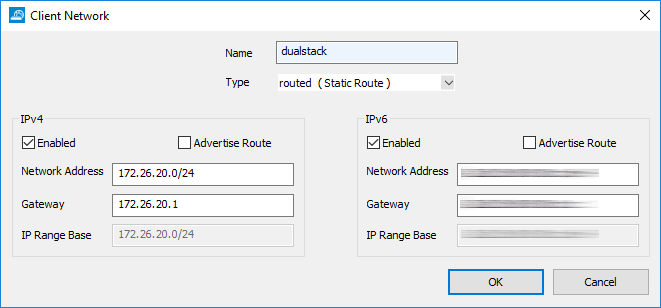
- Click OK.
- Upload the root certificate:
- In the left menu, select Root Certificates.
- Right-click the table and select Import CER from File or Import PEM from File. The Root Certificate window opens.
- Enter the Name for the root certificate.
- In the Usage section, select Barracuda Personal.
- (optional) Click the Certificate revocation tab to configure a CRL host.
- (optional) Click the OCSP tab to configure an OCSP server. For more information, see How to Configure OCSP Validation.
- Click OK.
- Upload the service key:
- In the left menu, select Service Keys.
- Right-click the table and select Import from File.
- Enter a Name.
- Click OK.
- Click Send Changes and Activate.
Step 3. Configure VPN Group Match Settings
- Go to CONFIGURATION > Configuration Tree > Box > Assigned Services > VPN-Service > Client to Site.
- Click Lock.
- Click the External CA tab.
- Click the Click here for options link. The Group VPN Settings window opens.

- In the Group VPN Settings window, configure the following settings:
In the X509 Client Security section, select X509 Certificate. This will force all users connecting to this firewall, regardless of the group policy, to use client certificate authentication.
In the Server section, select the Authentication Scheme:
- Default Authentication Scheme – The default authentication scheme is used for all VPN group policies.
- Extract from username – The authentication scheme is appended to the username. The authentication scheme with the appended name is used with the default authentication scheme acting as a fallback if the authentication scheme name is not present on the firewall. E.g.,
user1@msad1oruser2@domain.com@HQldap.
- (optional) To allow only one root certificate to be used for all group policies on this firewall, select the certificate from the Used Root Certificates list.
- Select which X.509 certificate field is to be verified by the Authentication Scheme selected above. Typically, this is the emailAddress, or username in the Subject.
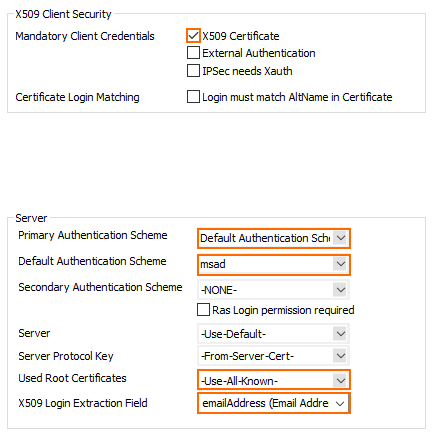
- Click OK.
- Click Send Changes and Activate.
Step 4. Create a VPN Group Policy
The VPN group policy specifies the network IPsec settings and defines the conditions to be met by the client certificate.
- Go to CONFIGURATION > Configuration Tree > Box > Assigned Services > VPN-Service > Client to Site.
- Click Lock.
- Click the External CA tab and then click the Group Policy tab.
- Right-click the table and select New Group Policy. The Edit Group Policy window opens.
Enter a name for the Group Policy.
- From the Network list, select the VPN client network.
In the Network Routes table, enter the network that must be reachable through the VPN connection. For example,
10.10.200.0/24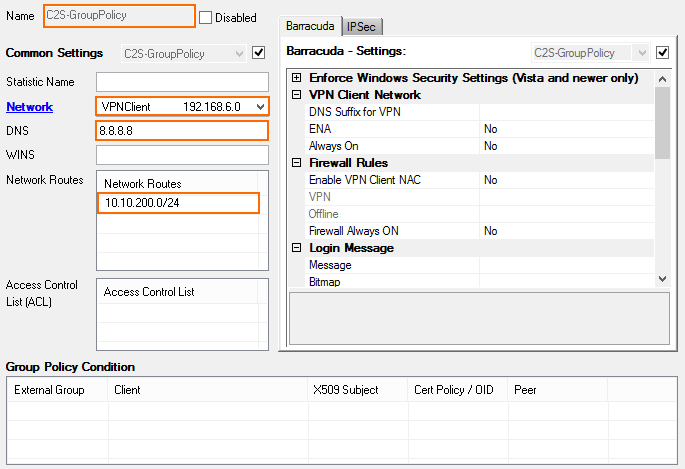
- Configure the group policy conditions. Only clients matching these conditions are allowed to connect through this group policy.
- Right-click the Group Policy Condition table and select New Rule. The Group Policy Condition window opens.
- (optional) In the Group Pattern field, define the groups on the authentication server that will be assigned the policy. E.g.:
CN=vpnusers* - In the X509 Certificate Conditions section, click Edit/Show. The Certificate Condition window opens.
- For each certificate condition, select the certificate field from the drop-down list, enter the required value, and click Add/Change.
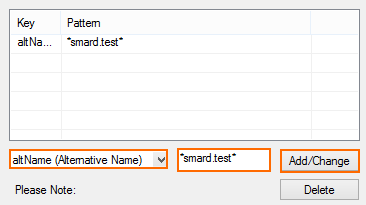
- Click OK.
- For each certificate condition, select the certificate field from the drop-down list, enter the required value, and click Add/Change.
- (optional) Enter an OID in the Certificate Policy to allow only certificates with a specific Key Usage. E.g., Client Authentication (1.3.6.1.5.5.7.3.2)
In the Peer Condition section, verify that Barracuda Client check box is selected.
- In the X509 Certificate Conditions section, enter matching conditions for the X.509 client certificates.
- Click OK.
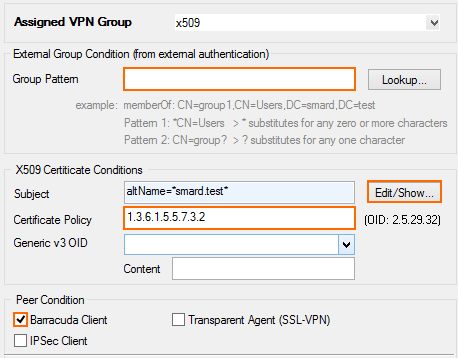
- Click OK.
- Click Send Changes and Activate.
Step 5. Add Access Rules
Add an access rule to allow traffic from your client-to-site VPN to your network. For more information, see How to Configure an Access Rule for a Client-to-Site VPN.
Monitoring VPN Connections
On the VPN > Client-to-Site page, you can monitor VPN connections. Clients authenticated via client certificate use a Name in the following format: <GroupPolicy name>-<certificate serial number>-<username>.

The page lists all available client-to-site VPN tunnels. In the Tunnel column, the color of the square indicates the status of the VPN:
- Blue – The client is currently connected.
- Green – The VPN tunnel is available, but currently not in use.
- Grey – The VPN tunnel is currently disabled. To enable the tunnel, right-click it and select Enable Tunnel.
For more information about the VPN > Client-to-Site page, see VPN Tab.
Troubleshooting
To troubleshoot VPN connections, see the /VPN/VPN and /Box/Control/AuthService log files. For more information, see LOGS Tab.
Next Step
Configure the VPN client to connect to this VPN profile. For more information, see Remote Access Clients.
